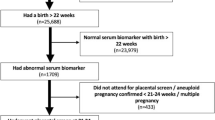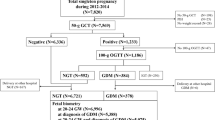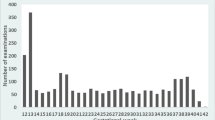Abstract
Objective:
To evaluate the performance of clinical estimation of fetal weight as a screening test for fetal growth disorders and then to estimate the effect of maternal body mass index (BMI) on its screening efficiency.
Study Design:
This was a retrospective cohort study of patients referred for third trimester ultrasound for the indication of ‘size unequal to dates’. Patients with medical co-morbidities that may alter their a priori risk for fetal growth disorders were excluded. The incidence of fetal growth disorders as well as amniotic fluid disturbances was determined for each group and then compared across maternal BMI categories of <25 kg m−2, 25–30 kg m−2, ⩾30 kg m−2 and ⩾40 kg m−2. To evaluate the accuracy of clinical estimation of fetal weight in predicting fetal growth disorders, the sensitivity, specificity, positive predictive value, negative predictive value, likelihood ratios, as well as number needed to scan (NNS) was calculated and compared across BMI categories.
Result:
Of 51 366 patients, 1623 were referred for the indication of size>dates and 1543 for the indication of size<dates. The incidence of fetal growth disorders in each referral group was low and was not significantly different across BMI categories. The sensitivity and specificity were 9.7 and 96.6% for predicting neonatal birth weight (BW)>90th percentile and 13.5 and 96.7% for predicting BW<10th percentile. The NNS to detect one neonate with a BW<10th percentile ranged from 5 to 19, whereas the NNS to detect one neonate with a BW>90th percentile ranged from 6 to 13 across BMI categories.
Conclusion:
Overall, clinical estimation of fetal weight yields a low detection rate of fetal growth abnormalities; however, its screening efficiency is not adversely impacted by maternal BMI.
This is a preview of subscription content, access via your institution
Access options
Subscribe to this journal
Receive 12 print issues and online access
$259.00 per year
only $21.58 per issue
Buy this article
- Purchase on Springer Link
- Instant access to full article PDF
Prices may be subject to local taxes which are calculated during checkout

Similar content being viewed by others
References
Lockwood CJ, Weiner S . Assessment of fetal growth. Clin Perinatol 1986; 13: 3–35.
Rondo PH, Maia Filho NL, Valverde KK . Symphysis-fundal height and size at birth. Int J Gynaecol Obstet 2003; 81: 53–54.
Hargreaves K, Cameron M, Edwards H, Gray R, Deane K . Is the use of symphysis-fundal height measurement and ultrasound examination effective in detecting small or large fetuses? J Obstet Gynaecol 2011; 31: 380–383.
Quaranta P, Currell R, Redman CW, Robinson JS . Prediction of small-for-dates infants by measurement of symphysial-fundal height. Br J Obstet Gynaecol 1981; 88: 115–119.
Persson B, Stangenberg M, Lunell NO, Brodin U, Holmberg NG, Vaclavinkova V . Prediction of size of infants at birth by measurement of symphysis fundus height. Br J Obstet Gynaecol 1986; 93: 206–211.
Calvert JP, Crean EE, Newcombe RG, Pearson JF . Antenatal screening by measurement of symphysis-fundus height. Br Med J 1982; 285: 846–849.
Sparks TN, Cheng YW, Mclaughlin B, Esakoff TF, Caughey AB . Fundal height: a useful screening tool for fetal growth? J Matern Fetal Neonatal Med 2011; 24: 708–712.
Lindhard A, Nielsen PV, Mouritsen LA, Zachariassen A, Sorensen HU, Roseno H . The implications of introducing the symphseal-fundal height-measurement. A prospective randomized controlled trial. Br J Obstet Gynaecol 1990; 97: 675–680.
Neilson JP . Symphysis-fundal height measurement in pregnancy. Cochrane Database Syst Rev 2009 Issue 1: CD000944.
Gardosi J, Francis A . Controlled trial of fundal height measurement plotted on customized antenatal growth charts. Br J Obstet Gynaecol 1999; 106: 309–317.
Wikstrom I, Bergstrom R, Bakketeig L, Jacobsen G, Lindmark G . Prediction of high birthweight from maternal characteristics, symphysis fundal height and ultrasound biometry. Gynecol Obstet Invest 1993; 35: 27–33.
Mongelli M, Gardosi J . Symphysis-fundus height and pregnancy characteristics in ultrasound-dated pregnancies. Obstet Gynecol 1999; 94: 591–594.
Alexander GR, Himes JH, Kaufman RB, Mor J, Kogan MA . United States national reference for fetal growth. Obstet Gynecol 1996; 87: 163–168.
McIntire DD, Bloom SL, Casey BM, Levino KJ . Birth weight in relation to morbidity and mortality among newborn infants. N Eng J Med 1999; 340: 1234–1238.
Morrison I, Olsen J . Weight-specific stillbirths and associated causes of death: an analysis of 765 stillbirths. Am J Obstet Gynecol 1985; 152: 975–980.
Intrauterine growth restriction. ACOG Practice Bulletin No. 12. American College of Obstetricians and Gynecologists. American College of Obstetricians and Gynecologists: Washington DC,, 2000.
Spellacy WN, Miller S, Winegar A, Peterson PQ . Macrosomia—maternal characteristics and infant complications. Obstet Gynecol 1985; 66: 158–161.
Fetal macrosomia. ACOG Practice Bulletin No. 22. American College of Obstetricians and Gynecologists. American College of Obstetricians and Gynecologists: Washington DC,, 2000.
Stevens-Simon C, McAnamey ER, Coulter MP . How accurately do pregnant adolescents estimate their weight prior to pregnancy? J Adolesc Health Care 1986; 7: 250–254.
Dekkers JC, van Wier MF, Hendriksen IJ, Twisk JW, van Mechelen W . Accuracy of self-reported body weight, height and waist circumference in a Dutch overweight working population. BMC Med Res Methodol 2008; 8: 69.
Jelks A, Cifuentes R, Ross MG . Clinician bias in fundal height measurement. Obstet Gynecol 2007; 110: 892–899.
Acknowledgements
Dr Goetzinger is supported by a training grant from the Eunice Kennedy Shriver National Institute of Child Health and Human Development (5 T32 HD055172) and from a NIH/NCRR/NCATS Washington University ICTS grant (UL1 RR024992). The contents of this publication are solely the responsibility of the authors and do not necessarily represent the official view of the NCRR, NIH or NCATS.
Author information
Authors and Affiliations
Corresponding author
Ethics declarations
Competing interests
The authors declare no conflict of interest.
Rights and permissions
About this article
Cite this article
Goetzinger, K., Tuuli, M., Odibo, A. et al. Screening for fetal growth disorders by clinical exam in the era of obesity. J Perinatol 33, 352–357 (2013). https://doi.org/10.1038/jp.2012.130
Received:
Revised:
Accepted:
Published:
Issue Date:
DOI: https://doi.org/10.1038/jp.2012.130
Keywords
This article is cited by
-
Fetal growth restriction: current knowledge
Archives of Gynecology and Obstetrics (2017)



